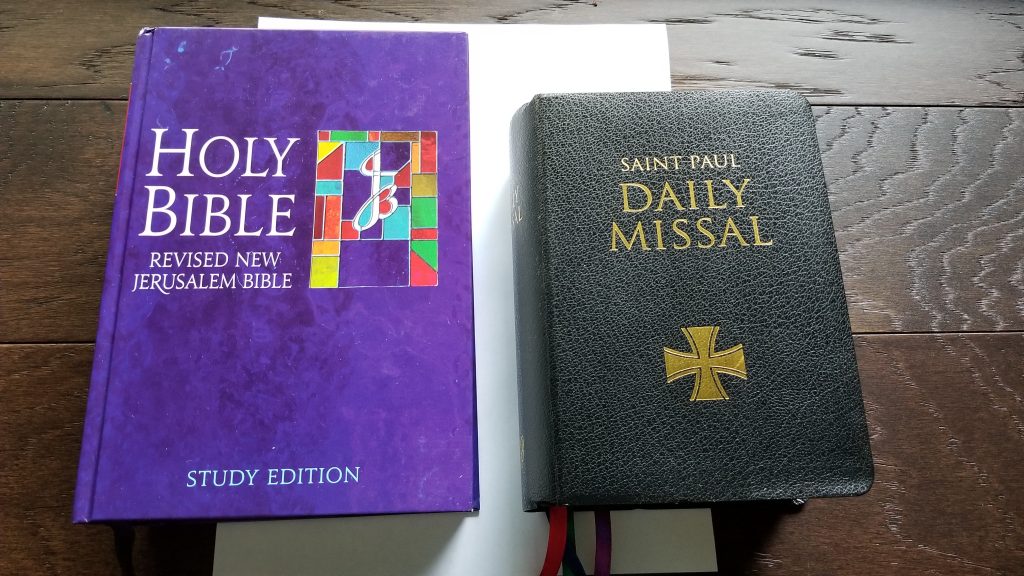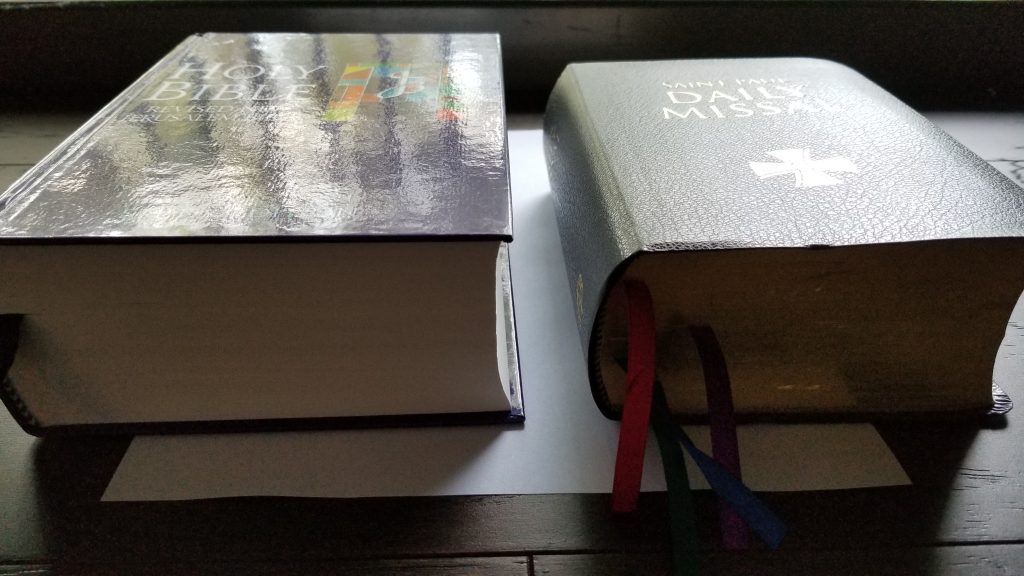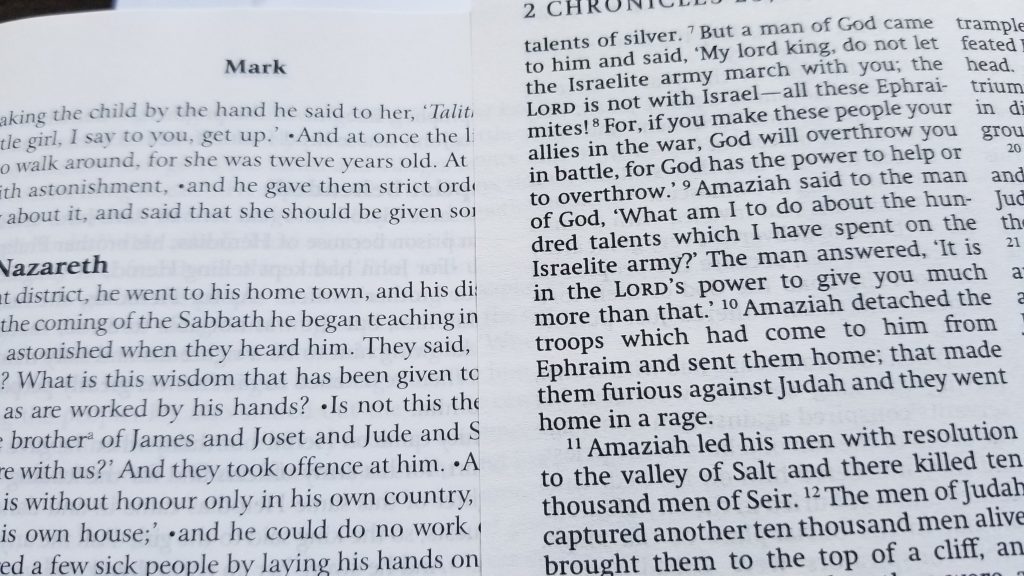I recently received my own copy of the RNJB from Book Depository, and I have a few additional details to add after seeing it in person. First of all, I can confirm that it features a sewn binding. Here is a clearer photo of the spine showing the sewn signatures:

As a side note, the photo appears to show only one ribbon marker, but I can confirm that there are two. The bible ships with both ribbons marking the same page.
One of the most striking things about this bible is its thickness. As Jeff Sagarin mentioned in the comments to the first RNJB photo post, the thickness measures about 2.5 inches from cover to cover (in metric units, that’s about 6.4 cm). Combined with its relatively small length and width, (5.4 inches X 7.8 inches or 137 mm X 198 mm), this bible looks very stout. It reminds me of the Saint Paul Daily Missal (which I reviewed a few months ago here). Here are a couple pictures of the two side-by-side:


Despite its thickness, this bible is actually comfortable to hold in one hand for reading. The narrow page width makes for less hand fatigue when supporting this bible with a single hand compared to other wider bibles.
Finally, I was struck by the small font size. For a thick bible with much more sparing notes than the Jerusalem Bible or the New Jerusalem Bible, I expected that the font size would be very comfortable. But it is slightly smaller and much less bold than the Cambridge hardcover REB (which uses size 8 font), as shown below:

I would classify the ghosting as average in this bible. I haven’t noticed anything that interferes with reading. The bible is not perfectly line-matched. In some places it appears to be, but the section headings cause subsequent lines to be out of alignment with the text on the other side of the page.
One additional quirk is that the book introductions use a larger font than the biblical text.
I’m very happy to see that Darton, Longman, and Todd kept the single-column layout which was used in the JB and NJB. There are so few Catholic bibles with single-column text, and if anything, it seems that publishers have been moving away from single-column settings in recent years. After publishing the New English Bible in single-column format, Cambridge and Oxford offered double-column editions of the REB. Congratulations to Darton, Longman, and Todd for continuing the single-column tradition!
I’m very interested to dive into this edition and compare it to the JB and NJB. For the next several Sundays, I’ll be featuring a comparison between all three translations for one of the Sunday Mass readings. Judging by Dom Henry Wansbrough’s previous comments, it sounds like the original JB text was a starting point for creating the RNJB, so I will be especially curious to see if it retains any influence from the NJB.
My copy just arrived in the mail today as well. I have read a few chapters in the middle of Genesis and it reads smoothly. But I would hardly call this a study bible.
I have to agree. The notes are far less extensive than the NJB. I would say the NJB was comprehensive and detailed enough to rival the New Oxford Annotated Bible. The only thing it didn’t have was the additional scholarly articles.
On the other hand, maybe that’s a good thing. I have a love/hate relationship with study bibles. When i’m traveling, I appreciate being able to bring a study bible which serves as a one-stop resource. But when I’m at home, I often prefer a reader’s bible with no notes. If I want to study something in greater depth, I pull a commentary or a study bible off the shelf.
Well, I’m happy to see that (based on the photos posted so far) the inclusive language in the RNJB is less extreme than that in the NRSV. It seems fairly comparable to the NABRE. Adelphos seems to be rendered “brothers and sisters” a lot (1 Corinthians 14:26-39). I don’t love “brothers and sisters”, but I prefer it to the NRSV’s horrible practice of sometimes rendering adelphos as “neighbors” or “believers”, thus conflating different Greek words and completely ruining the word’s intimate familial character. Meanwhile, Psalm 8 uses the word “man” rather than the bizarre “mortals”, and it does not pluralize what is singular in the original, using “he” rather than “they.” My sample size is still very small, of course, but things look hopeful.
Now, I still very much hate “physical” for psychikon (1 Corinthians 15:44) and “body” for sarx (Colossians 1:44). But I suppose no translation can withstand having every individual word nitpicked, even if I cannot understand how these word choices could possibly have been made. And I’m disappointed the notes in the “study edition” are less extensive than they were in the NJB.
But overall, I like the RNJB more than I expected to. Previously, I just sort of thought of it as redundant with the NABRE, with whom it seems to share almost exactly the same degree of literalness and inclusive language. But now I’m glad it exists, and I even think it should be chosen for the UK lectionary. Not because I think the ESV is deficient like the PrayTellBlog people; it seems obvious to me that they dislike it because it’s the darling of conservative Evangelicals, and the PrayTellBlog crowd really don’t like conservative Evangelicals. But given that the UK is used to the Jerusalem Bible and the RNJB looks solid, the RNJB seems like the obvious choice.
To become more acquainted with Fr. Wansbrough, I listened to his 4-hour lecture titles “He Lives” from Now You Know Media (it’s available for free on Hoopla). The lecture is really good and I recommend it. For one thing, he has an incredible British accent. He sounds like an Oxford Don from the 1940s or something, like the recordings we have of C.S. Lewis. For another thing, he tells multiple anecdotes about his time leading tours in the Holy Land, all of which make his tours sound like crazy adventures involving a high likelihood of getting arrested or killed.
He struck me as a bit more believing and traditional than expected, relative to some of the other Now You Know Media lecturers, and relative to the Catholic historical-critical establishment as a whole. He is not as constantly demythologizing as others. He explicitly suggests at one point that many of the details in the passion narratives never happened and that the evangelists later just made them up or assumed they must have happened. But there are other passages where he seems to assume (or even explicitly defends) the reality of specific events, up to and including resurrection appearances.
In the lecture he comes off to me as a bit hypersensitive to charges of antisemitism. He even insults the second volume of Pope Benedict’s Jesus of Nazareth for allegedly accepting an antisemitic theory, though he softens the blow by saying nice things about Pope Benedict personally and about the other two Jesus of Nazareth volumes. Oddly, though, he defends the gospels’ characterization of Pontius Pilate (over against Josephus) as a reasonably effective governor who probably would have tried to get out of having Jesus executed on dubious charges.
Would it be too much to ask to include the NABRE in your serious? Deficits in the formatting of this Bible aside, I feel that this translation has the potential to be the best balance between readability and the formal equivalence approach.
With the notes and formatting of this particular Bible aside, I feel this translation might be the best balance between readability and formal equivalence. Would it be possible to add the NABRE into the mix?
Sure! I was originally thinking about including the NABRE since most readers in the US have been hearing the NAB at Mass in the same way UK readers have been hearing the JB. I chickened out, since i didn’t want to overload everyone with too many translations. But I would certainly be interested in comparing the JB/NJB/RNJB with the NABRE. I’ll include it.
Now the stateside query, only answered perhaps this coming December, “What will the Penguin Random House edition look like?” Maybe a “tugging” at Penguin to allow us a sample?
I have the DLT edition, too. It’s a wonderful edition, though my wife jokes that the cover looks very “seventies.” I wish the font was slightly larger, but I do like the size of the Bible. It’s very portable.
I suspect the stateside edition will have a glued binding, which I would find untenable, given that it would likely be the only edition available (unless you order from the UK). This was the case with the NJB. I found them from the UK with sewn binding but in the states, the more recent editions (the famous blue hardback, for instance) are glued. Some older Doubleday editions did have sewn binding. I’m extremely picky about binding, especially when it comes to Bibles, which should last.
I’m also worried about the binding for the US edition. I really hope that Image/Random House will keep the single column layout and offer a sewn binding. It’s disappointing that the Doubleday hardcover NJB has a glued binding. Doubleday also published a bonded leather NJB, and my impression was that the binding was glued in that edition also. It’s been a while since I’ve seen one in person, though, so I could be mistaken.
Marc,
You’re not mistaken. I purchased that Doubleday bonded leather edition years ago and when I realized it was glued, I gave it to my wife, who could care less about binding (some things are a mystery to me). I appreciate that we have access to a sewn edition, though, through DLT. And though I prefer a genuine or premium leather cover on Bibles, I’d take a hardcover over bonded leather nay day oft he week! At least it will last.
I just came here to give some more love to the St Paul Daily Missal. It’s been my daily companion for 5 years. I’ve beat that thing up and it still lives!
I’ve been enjoying it too! I’m glad to hear that it’s holding up well for you.
Found a typo in the headline for 2 Kings 25:27, in the name of the king ‘Jehoiachin’ (page 577), which was spelt ‘Johoiachin’. Probably missed by the proofreader.
Lots of typos, both the Study and the Readers editions. Sad.